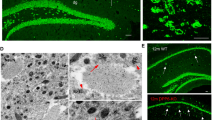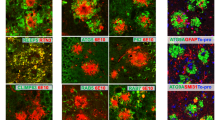Abstract
This study presents evidence for plasma membrane abnormalities of the dystrophic neurites in senile plaques of Alzheimer's disease. We found that the plasma membranes of dystrophic neurites are more labile to fixation than those membranes of other cells of the senile plaque or of normal neurites distant from senile plaques. Further, we found vesicles in the extracellular space adjacent to dystrophic neurites and similar to those within them, suggesting that the increased lability seen in our preparations may, in vivo, be associated with release of neuritic contents. Plasma membrane alterations may be critical to deposition of amyloid-β in senile plaques from the abundant β-protein precursor of dystrophic neurites. The consequences of altered membrane integrity, such as calcium influx, lipid peroxidation and free radical damage, could also be responsible for many of the pathological correlates of the disease.
Similar content being viewed by others
Author information
Authors and Affiliations
Additional information
Received: 28 July 1995 / Accepted: 7 September 1995
Rights and permissions
About this article
Cite this article
Praprotnik, D., Smith, M., Richey, P. et al. Plasma membrane fragility in dystrophic neurites in senile plaques of Alzheimer's disease: an index of oxidative stress. Acta Neuropathol 91, 1–5 (1995). https://doi.org/10.1007/s004010050385
Issue Date:
DOI: https://doi.org/10.1007/s004010050385




